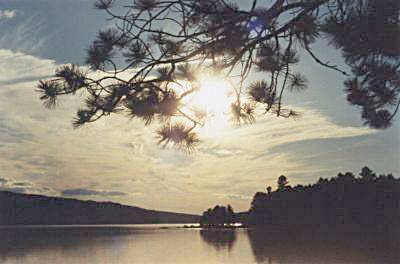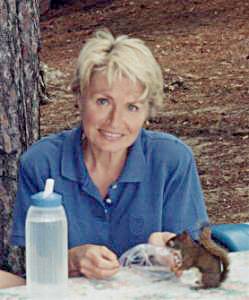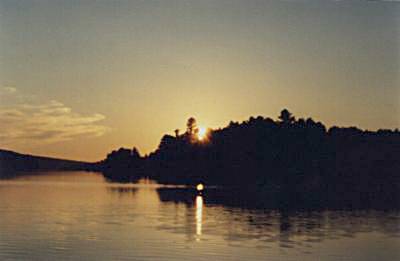 |
Barron Canyon Canoe
and Camping Trip Part 1 - Grand Lake |
| Go to Part: 1 2 3 4 |
More Canoe Stories |
Park Information |
Maps |
Part 2 |
 After two years into retirement and
having undertaken some wilderness trips with my
canoeing buddies into the northern regions of
Algonquin Park, I felt that it was time to ask my
wife, Geri, to accompany me on a camping trip to
the High Falls and Barron Canyon region of
Algonquin Park. As walking is Geri’s
‘passion’, I threw in a promise of some
interesting hiking trails as an enticement. Over
the years, Geri has patiently endured stories of
my trips as well as assisted with the editing of
my stories for publication on Jim Hegyi’s
website, so I wasn’t surprised when she
accepted the challenge. After two years into retirement and
having undertaken some wilderness trips with my
canoeing buddies into the northern regions of
Algonquin Park, I felt that it was time to ask my
wife, Geri, to accompany me on a camping trip to
the High Falls and Barron Canyon region of
Algonquin Park. As walking is Geri’s
‘passion’, I threw in a promise of some
interesting hiking trails as an enticement. Over
the years, Geri has patiently endured stories of
my trips as well as assisted with the editing of
my stories for publication on Jim Hegyi’s
website, so I wasn’t surprised when she
accepted the challenge. July 15 – Our gear was packed into the car the previous night, leaving only the canoe to be secured on top of the car and our food supply to be put into coolers in the morning. As we departed, sunshine, light clouds and a cool breeze were great indicators of a fantastic day ahead. At the Sand Gate Station, park staff cheerfully welcomed our arrival. Upon registering, and to our surprise, we were informed that a better campsite was available and that we would not be disappointed if we decided to take it. After travelling for 25 km on a dirt road that led us into the interior of the park, we arrived at the Achray Campgrounds and were confronted with a campsite that was situated under tall pine trees with a sandy beachfront facing Grand Lake and the promise of some beautiful westerly sunsets. We soon experienced the antics of two squirrels who became known as "Chip" and Dale". When we stopped for a quick lunch before setting up camp, the squirrels got right beside Geri and patiently waited to lick the remains of the jam and peanut butter from the zip-loc bag.
As we were about to enter a wetland, we approached two lone baby loons and soon caught sight of their frantic parents shrieking and rushing to their protection. We paddled slowly to allow them ample time to distance themselves from us. Although the bay was very active with various waterfowl, such as the red headed merganser duck and the mallard, the lily pads with their white and yellow flowers touched the area with serenity. Leisurely following the shoreline, we came upon a family of four fishing. They had just caught a small bass and placed it upon a rock where the fish was immediately eaten by a water snake. The snake could be seen entering the water among the rock crevices and then swimming towards the edge of the canoe with its head just above the surface and its body markings very distinct in the clear water.
A pleasant park employee informed us that the log cabin situated next to the stone administration building was the one used by Tom Thomson, a Group of Seven Canadian artist, who frequented Algonquin Park during the early part of the 1900’s until his death in a canoeing accident. On his suggestion, we later visited an area of Grand Lake where Thomson painted his famous "Jack Pine" scene.
|
| Go to Part: 1 2 3 4 |
More Canoe Stories |
Park Information |
Maps |
Part 2 |
Copyright
2001 by Norm Hooper
http://www.canoestories.com/barron1f.htm

 With our campsite finally put in order,
I took the first opportunity to go for a
refreshing swim in the lake. Later, we canoed the
shoreline to familiarize ourselves with the area.
By 2pm, we decided to cross Grand Lake in search
of the native pictographs on one of the many
ledges leading into Carcajou Bay. Undeterred from
not locating any, we retraced our route and
finally found, what we later learned from a park
employee, was the ‘one and only’
pictograph on a rock surface near the
water’s edge– a reversed letter
"F" in red-ogre with faint markings
surrounding it.
With our campsite finally put in order,
I took the first opportunity to go for a
refreshing swim in the lake. Later, we canoed the
shoreline to familiarize ourselves with the area.
By 2pm, we decided to cross Grand Lake in search
of the native pictographs on one of the many
ledges leading into Carcajou Bay. Undeterred from
not locating any, we retraced our route and
finally found, what we later learned from a park
employee, was the ‘one and only’
pictograph on a rock surface near the
water’s edge– a reversed letter
"F" in red-ogre with faint markings
surrounding it.  As
we continued down the lake, the scent of various
coniferous trees and flowers was very prevalent
and in one particular area, there was a strong
fragrance that resembled strawberries, but none
could be seen. We passed two campers sitting at
their site overlooking and enjoying the
peacefulness of the lake – to us this was
what it was all about. We crossed the lake to
take a closer look at the Brant cottage located
on a high, rocky isthmus – a perfect place
to spend summer vacations. We found the waters of
Grand Lake to be extremely clean - due in part by
the abundant plant life along the shore, the
clams found on the sandy lake bottom and the
park’s conservation program. After three
hours of paddling, we returned to our camp to
swim and later enjoyed a leisurely walk about the
campground - to our delight, we noticed a
beautiful Baltimore oriole in a large pine - a
bird that is not very common to the backyards of
Ottawa.
As
we continued down the lake, the scent of various
coniferous trees and flowers was very prevalent
and in one particular area, there was a strong
fragrance that resembled strawberries, but none
could be seen. We passed two campers sitting at
their site overlooking and enjoying the
peacefulness of the lake – to us this was
what it was all about. We crossed the lake to
take a closer look at the Brant cottage located
on a high, rocky isthmus – a perfect place
to spend summer vacations. We found the waters of
Grand Lake to be extremely clean - due in part by
the abundant plant life along the shore, the
clams found on the sandy lake bottom and the
park’s conservation program. After three
hours of paddling, we returned to our camp to
swim and later enjoyed a leisurely walk about the
campground - to our delight, we noticed a
beautiful Baltimore oriole in a large pine - a
bird that is not very common to the backyards of
Ottawa. After
a late supper, we sat around our campfire and
enjoyed a chorus of loons, bullfrogs and whipper
wills as the sun began to set. The rolling
hillside across the lake and the blue sky lined
with scattered clouds reflected beautifully upon
the still lake, resulting in a very picturesque
scene. I took the canoe out onto the lake for a
final view of the setting sun - it was evident
another warm summer day was in store for us. By
10:30 pm, we were snuggled into our sleeping
bags; however, sleep didn’t come easily for
me as I was only too aware of the constant calls
of the loons, the bullfrogs croaking in a cove
next to our camp, and the screaming of countless
gulls on an island in the middle of the lake.
Geri, however, was completely undisturbed and
slept soundly.
After
a late supper, we sat around our campfire and
enjoyed a chorus of loons, bullfrogs and whipper
wills as the sun began to set. The rolling
hillside across the lake and the blue sky lined
with scattered clouds reflected beautifully upon
the still lake, resulting in a very picturesque
scene. I took the canoe out onto the lake for a
final view of the setting sun - it was evident
another warm summer day was in store for us. By
10:30 pm, we were snuggled into our sleeping
bags; however, sleep didn’t come easily for
me as I was only too aware of the constant calls
of the loons, the bullfrogs croaking in a cove
next to our camp, and the screaming of countless
gulls on an island in the middle of the lake.
Geri, however, was completely undisturbed and
slept soundly.